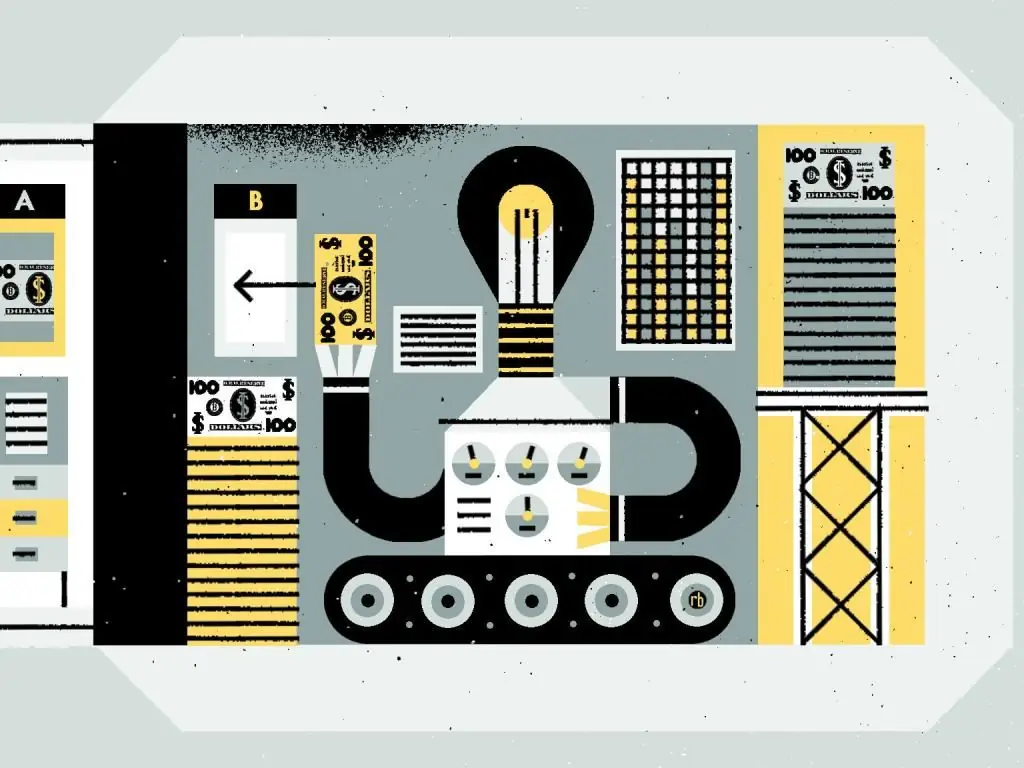2026 Author: Howard Calhoun | [email protected]. Last modified: 2025-01-24 13:10:26
The essence of business is to satisfy the needs of customers through the provision of services or goods. The existence of production management in the enterprise indicates the application of the concepts of business organization and quality management in the creation of products. For organizations to be competitive, it is essential to create value for customers and solve their problems. In the article we will talk about why and who needs high-quality production management at the enterprise, as well as how it indirectly affects our well-being.
Basics
Production is the creation of goods and services for subsequent consumption by society. It means the transformation of resources into products in accordance with the needs of society. Production management is the application of the principles of control over the production process of an enterprise. It covers all activitieswhich a set of factor components is transformed into a social product. It includes the application of planning, organizing and controlling the production process.
The main goal of production management is to create goods and services of the required quality in the required quantity at minimal cost. An effective organization is able to adequately withstand competition.
Management of production ensures full or optimal use of available production capacity. It deals with making decisions related to the production process. In this way, goods and services are produced in accordance with the quantity requirements and the demand schedule while respecting the minimum cost.
Economics of the enterprise and production management is a set of general principles of economy of production, design of facilities and jobs, scheduling, quality control, inventory control, cost and budget. Here planning and control come to the fore as the main activities.
General view

Production is a scientific process that involves the transformation of raw materials (materials) into a desired product or service (commodity) by adding economic value. It can be classified into the following types:
- Production based on separation of processes, which includes the desired result achieved by separating or extracting the desired substances from raw materials. The classic example isoil production and manufacture of various petroleum products.
- Production by modification or improvement involves changing the chemical parameters of raw materials without changing the physical properties. A subject that fits the description could be a steel plant where the annealing process or heating at high temperatures takes place, as well as the cooling of alloys.
- Production including assembly of parts. An example of such output would be the assembly of automobiles or computers.
Product management in an enterprise is the work of coordinating and controlling actions that accompanies the process of creating a product. Usually includes effective control over planning, cost, performance, quality, and waste requirements.
Functions
General best practices in the production management system have remained unchanged for decades, but the systems and methods used to ensure the production of high-quality products have undergone significant changes. Systems that once seemed perfect are outdated and are now unable to cope with the growing needs of today's markets.
The purpose of the production management function in an enterprise is to add value to a product or service, which will create long-term relationships with customers or organizations.
Field of activity

Competitive pressures are forcing production management to take a broader look at production systems. The focus is shifting from planning todevelopment of a production management system. And sometimes - even from internal production planning and control to interorganizational aspects. The structure of production management in the enterprise takes into account many factors. Often, due to the lack of time for data processing, computerized support tools are required in addition to a structured and modular approach. Enterprise simulation is the area where simulation models are most widely known.
The field of production management is huge. It includes choosing the location of production, constructing buildings, purchasing and installing equipment, acquiring and storing raw materials and turning them into commercial products. To the above, control of production, quality and maintenance, planning, optimization and automation of work is added.
For small, custom-made enterprises, the production management system of the enterprise will be different from that of large industrial enterprises.
Choice of production process

With increasing production volumes, standardized materials and specialized equipment are used to minimize costs. Evolution in the process structure is often associated with a stage in the product life cycle.
The choice of production management process for an industrial enterprise is a strategic decision. The management must decide what technology to use in the workshop, batch shop, assembly line, what machines and equipment are required, whatmaterial handling system.
Choosing the right production capacity
The production manager carries out competent production management at the enterprise, based on capacity indicators. Overcapacity will result in machine and equipment downtime, and undercapacity will not be able to meet demand. The production manager must determine the required power level for both the short and long term. Capacity selection includes break-even analysis.
Planning

At this stage, the production manager at the plant makes the routing and scheduling decision.
Routing can be defined as the process of determining the path (route) of work and sequence of operations. This ensures uninterrupted operation and optimal use of resources. The manager determines in advance the quantity and quality of the required raw materials, labor resources, machines and materials; types and number of processes, sequences in which operations will be organized.
Planning involves fixing the amount of work. To do this, the various production operations are organized in order of importance. The start and end, date and time for each operation are recorded. For this, various schedules and control methods are used.
Control
The head of production control at the enterprise must make sure that production plans are followed. If he finds anydeviation in the production shop, he must take corrective action.
Quality and cost control

To remain competitive in the market, businesses must produce high quality products at the lowest cost. Therefore, quality and cost control is one of the important functions of production management in an enterprise.
The final cost of the product varies depending on the optimal use of resources, the cost of inventory and the cost of storing finished products.
The amount of product at each stage of production must be evaluated in terms of procurement, storage and quality. Correctly capturing information such as time spent on production, cost levels and their impact on other processes in the context of different production stages helps to identify bottlenecks and opportunities for optimization and automation.
Stocks
The head of production management at the enterprise must monitor the level of stocks. Due to overstocking, the working capital of the enterprise is blocked, during the shortage of goods, production schedules are violated and the quality of delivery of finished products is reduced. Therefore, the production manager must maintain a certain level of inventory, which would not lead to either overstocking or product shortages.
Just-In-Time (JIT) and Lean manufacturing concepts are applied to optimize resource utilization and minimize or eliminate inventory.
Technicalservice
To ensure uninterrupted control of the production process, the company uses machine tools, machines, equipment. At the most inopportune moment, they can fail, which will shift the delivery schedule of products, so regular scheduled maintenance is necessary. Preventive maintenance is better than a breakdown, so check and repair schedules should be established. Such schedules should not affect the production schedule.
Constant inspection (regular checks), cleaning, lubrication, maintenance, replacement of old equipment parts, ordering spare parts are the tasks of the head of the production department.
Benefits for the enterprise

- Achieving goals. The basics of production management at the enterprise help him achieve his goals. The company produces only those products that satisfy the needs and desires of customers. If, after conducting market research, the conclusions are made correctly, in the near future the company will increase sales and revenue.
- Reputation, brand and image. Production management helps the firm to meet the needs of customers. It indirectly contributes to improving the reputation of the company, its perception. A good image helps a firm grow and expand.
- Fostering the introduction of new products. Production management helps to experiment and introduce new products to the market. In an industrial enterprise, research and development (R&D) is indispensable. They help the firm develop new, betterquality products.
- Support for functional areas. Operations management supports other functional areas in an organization such as marketing, finance, and human resources. It will be easier for the marketing department to sell high-quality products, and the finance department will receive more funds from increased sales. An enterprise can be given a loan that can be used for expansion and modernization. The HR department will be able to effectively manage human resources if the production department is highly productive.
- Help fight competition. Production management helps the firm to resist competition in the market. This is due to the fact that, thanks to him, products are produced in the required quantity and quality, and the price for it is set at the one that will be of interest to the buyer.
- Optimal use of resources. Production management promotes the optimal use of resources such as labor, machinery and raw materials. Thus, the firm can achieve its goals with the effective use of production capacity. The result will be higher profits for the organization.
- Expansion of the enterprise. Production management helps a firm grow and expand. Improving product quality and cutting costs helps the firm earn higher profits.
Benefits for consumers and society

- Higher standard of living of the population. Production management leads to continuous research and development (R&D),in short, new and improved products. People use the products and enjoy a higher standard of living.
- Increase in employment. Thanks to industrial activities in the country, directly or indirectly, many different employment opportunities are created. Direct employment is typical for the manufacturing sector, while indirect employment is created in ancillary areas: marketing, finance, customer support.
- Improve quality and reduce costs. Production management improves product quality because research and development is carried out. Large-scale production with rationalization faces economies of scale, which reduce the cost of production per unit of output. This is beneficial for the consumer as the consumer price level is decreasing.
The management of the production and sale of the company's products ensures the optimal use of resources and the efficient production of goods and services, which leads to rapid economic growth and the well-being of the nation.
Recommended:
Staffing of the personnel management system. Information, technical and legal support of the personnel management system

Since each company determines the number of employees independently, deciding what requirements for personnel it needs and what qualifications it should have, there is no exact and clear calculation
Centralized management: system, structure and functions. Principles of the management model, pros and cons of the system

Which management model is better - centralized or decentralized? If someone in response points to one of them, he is poorly versed in management. Because there are no bad and good models in management. It all depends on the context and its competent analysis, which allows you to choose the best way to manage the company here and now. Centralized management is a great example of this
Production program as a tool for effective enterprise management

The production program is a plan of the enterprise for one year, broken down into quarters, which indicates the amount of products to be produced and the financial costs of production
Production management is an effective tool for enterprise management

Production management is a part of cybernetics that explores and studies management processes at the microeconomic level. As in any scientific direction, there are subjects and objects of management. The subjects are the heads of the enterprise and various management bodies. The objects are the business entities themselves, employees or labor collectives, natural resources, as well as information and scientific and technical potential
Organization management is an enterprise management system

Management of an organization is the creation of a business model of an enterprise and the most effective management of it

